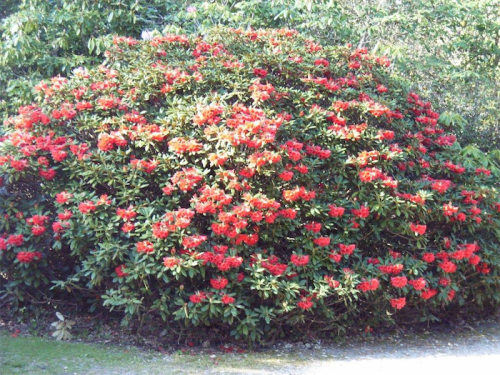
NATURE is truly amazing; no matter how hard the ground, bulbs have a way of pushing their leaves through in places that I cannot remember ever planting.
I am also looking at the buds of that spectacular plant, the rhododendron, as they struggle through into flower. The nature of its delicate petals makes it hard to imagine the plant comes from one of the coldest areas of the world, Himalaya.

MEMBER of the famous banking family, Lionel de Rothschild (1882-1942) possibly bred and promoted more rhododendrons than any other person.
In 1912 he bought a 100-hectare Hampshire estate in southern England and started on his hobby of breeding plants. World War I interrupted his vision, but after the war he bought an adjoining estate of 1000 hectares to establish the famous Exbury Gardens.
He expanded his special interest in breeding rhododendrons and azaleas by organising plant hunters to bring specimens from China, Tibet and Himalaya.

To establish his gardens the woodland undergrowth had to be cleared, so he employed 250 men from surrounding farms who then double dug initially about 100 hectares, adding peat but no inorganic fertilisers. A borehole was sunk and an irrigation system spread out from the water tower to reach all parts of the garden through some 35 kilometres of underground piping.
He employed an additional 60 experienced gardeners plus a further 15 to work in the breeding program in the glasshouses.
Neither money nor effort was spared in pursuit of horticultural excellence raising some of the most magnificent hybrid rhododendrons ever seen.
Exbury Gardens is open to the public and, believe me, not a garden to be missed if you are in southern England. April to June is the best time to visit.
IN Commonwealth Park we see the usual unreal display of flowers of Floriade, open until October 14. This year’s theme is “Pop Culture”, of which I am sure no one can really work out.
One story worth mentioning is of the inimitable head gardener Andrew Forster, who is responsible for organising the massive job of planting out the site. This is his 22nd year.
Some years ago the City Parks powers-to-be, in their infinite wisdom, moved Andrew to other duties at the start of planting. Almost immediately they recognised the error of their ways and Andrew was quickly brought back to sort things out.
Well done, Andrew, the results speak for themselves once again with a sea of colour.

ONE can hardly miss seeing the bright blue of Ceanothus Blue Pacific (or Californian Lilac) in many gardens.
It is quite different to almost any other evergreen plant and it’s very important to lightly prune it every year immediately after flowering from the day it is first planted. If left for a few years and then hard pruned, it won’t grow again on the old wood.
CONGRATULATIONS to mayor Tim Overall and the Queanbeyan Palerang Council with their Captains Flat improvements.
The council’s horticultural staff recently planted a fruit grove around the Colin Winchester Oval.
The trees include pears, almonds, apricots, cherry, fig, plum and pomegranate. The trees will be maintained by the local community. This is all part of a wider project to upgrade community facilities at Captains Flat funded by the NSW government’s Stronger Community Fund in conjunction with the local council.
Jottings…
- Time to select rhodos and azaleas as they come into flower at garden centres, but make sure of the space available for growing rhodos and check the labels, they grow from dwarf varieties one metre tall to more than four metres.
- Use only certified organic fertilisers when preparing the soil for planting.
- Rhodos and azaleas require filtered shade, under deciduous trees is ideal, allowing winter sun and summer shade.
Who can be trusted?
In a world of spin and confusion, there’s never been a more important time to support independent journalism in Canberra.
If you trust our work online and want to enforce the power of independent voices, I invite you to make a small contribution.
Every dollar of support is invested back into our journalism to help keep citynews.com.au strong and free.
Thank you,
Ian Meikle, editor




Leave a Reply